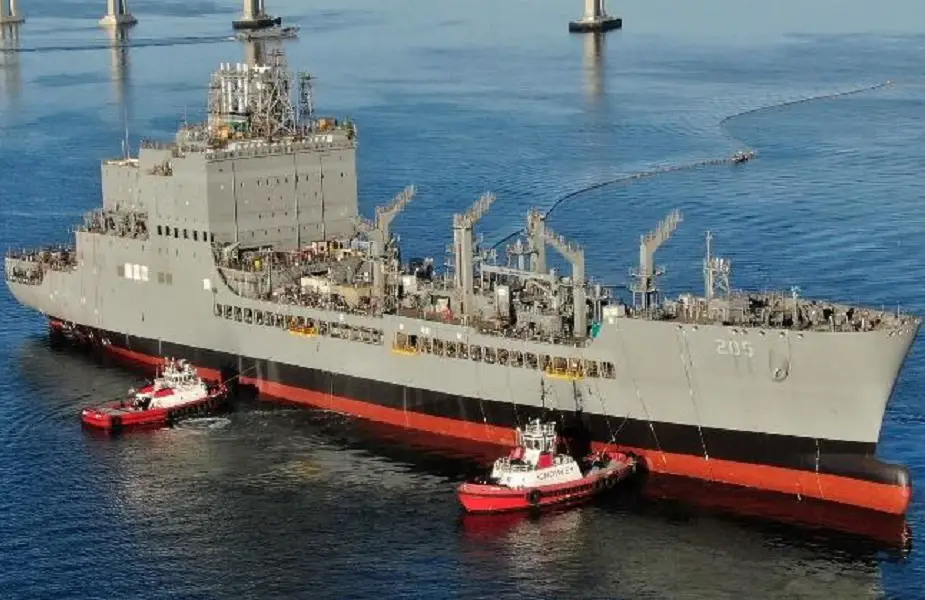Breaking news
Austal USA awarded preliminary design contract for US Navy Next Generation Logistics Ship Program.
Austal Limited is pleased to announce Austal USA has been awarded a US$2 million (~ A$2.8 million) contract to perform design studies for the United States Navy’s Next Generation Logistics Ship (NGLS) program.
Follow Navy Recognition on Google News at this link
 The Navy’s current CLF ships include oilers (TAOs), dry cargo and ammunition ships (TAKEs), and fast combat support ships (TAOEs). Pictured here, USNS John Lewis (T-AO 205) (Picture source: General Dynamics)
The Navy’s current CLF ships include oilers (TAOs), dry cargo and ammunition ships (TAKEs), and fast combat support ships (TAOEs). Pictured here, USNS John Lewis (T-AO 205) (Picture source: General Dynamics)
The contract requires Austal USA to develop a new baseline design and perform specific trade studies for the Navy’s newest logistics ship.
Austal Limited Chief Executive Officer Paddy Gregg said the contract was another significant step forward in Austal USA’s expansion into steel naval ship design and construction.
“Adding to the concept design work Austal is already undertaking for the US Navy’s Light Amphibious Warship (LAW) program and the recent construction contract for up to five Towing, Salvage and Rescue (T-ATS) ships, this contract further demonstrates Austal USA’s capabilities and commitment to steel naval ship design and construction,” Mr Gregg said.
The United States Navy’s NGLS program represents a new class of medium-sized, at-sea supply ships intended to support small surface combatants such as Littoral Combat Ships (LCS) and frigates as well as the Navy’s planned Light Amphibious Warships (LAW). The mission of the NGLS fleet will include re-fuelling, re-arming, and resupply of naval assets.
Austal USA’s reputation for completing major naval vessel contracts, including the Independence-class Littoral Combat Ship (LCS) and Spearhead-class Expeditionary Fast Transport (T-EPF) programs on schedule and on budget gives the company a strong foundation to provide a highly capable and cost effective NGLS design to the United States Navy.
About the NGLS Program:
The Navy’s Combat Logistics Force (CLF) ships, also called underway replenishment (UNREP) ships, are logistics ships that resupply the Navy’s combatant ships (e.g., aircraft carriers, surface combatants, and amphibious ships) at sea, so that the combatant ships can continue operating without having to return to port. The Navy’s current CLF ships include oilers (TAOs), dry cargo and ammunition ships (TAKEs), and fast combat support ships (TAOEs).
To more effectively counter the improving A2/AD capabilities, the Navy wants to begin shifting to a new, more distributed fleet architecture that is to include a reduced proportion of larger ships and an increased proportion of smaller ships. This more distributed fleet architecture is intended to support a new Navy and Marine Corps operational concept for countering adversary A2/AD forces, called Distributed Maritime Operations (DMO), and an associated new Marine Corps operational concept called Expeditionary Advanced Base Operations (EABO).
DMO aims at avoiding a situation in which an adversary could defeat U.S. naval forces by concentrating its attacks on a relatively small number of large, high-value U.S. Navy ships. Under EABO, relatively small Marine Corps units armed with anti-ship cruise missiles and other weapons would hop on and off islands in the Western Pacific to conduct “shoot-and-scoot” operations against adversary ships.
The NGLS program, also known as the Next-Generation Medium Logistics Ship program, was initiated in the Navy’s FY2021 budget submission. The program envisages building a new class of CLF ships that would be smaller and individually less expensive to procure than the Navy’s current CLF ships. Like the Navy’s current CLF ships, NGLSs would be operated by MSC with mostly civilian crews. The Navy states that Navy Next-Generation Logistics Ship (NGLS) Program. The Navy states that the Next Generation Logistics Ship (NGLS) is planned to be a new class of ships to augment the current Combat Logistics Force ships, through the use of commercial ship designs tailored for military applications to conduct logistics missions. The NGLS will enable refueling, rearming, and resupply
of Naval assets—afloat and ashore—in support of Distributed Maritime Operations, Littoral Operations Contested Environment, and Expeditionary Advanced Base Operations.
The NGLS is envisioned to be smaller than existing ships in the Combat Logistics Force, and will operate near contested environments, sustaining afloat (Surface Action Group) and ashore (Expeditionary Advanced Base) requirements. NGLS is potentially a family of vessels with commercial designs tailored for military applications. RDT&E [research, development, test, and evaluation] funding will continue to support requirements trade-off studies, development of indicative [i.e., notional] designs, specification development, and demonstrations of experimentation and proof-of-concepts focused on the Refuel, Resupply, and Rearm logistics missions.


























